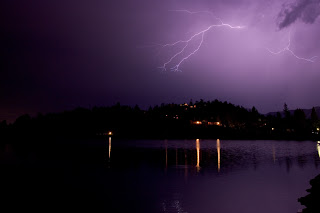
My first attempts at lightning go back about 11 years, when I tried to shoot lightning using my reflexes...needless to say nothing came out. Few years later, armed with a better camera, I tried again during a storm, and only got a few keepers. Either my reflexes got better, or I was lucky.
It made me realize there must be a better way to shoot lightning...after some research and thought, I learned the secret...and today I'll share the secret to getting lightning shots like this:
You'll need a few tools to shoot lightning. One is a good camera, preferably a digital SLR. Although film SLR will work, as well as some point and shoot models (One that allows longer shutter speeds). You'll also need a tripod to keep the camera steady. And the final item, is a cable release...this will greatly increase your ability to shoot lightning.
Here are the steps to follow for shooting lightning (These are based on using a digital SLR, other cameras would be similar):
- Start with a wide angle lens to cover more sky area, this will give you a better chance of getting lightning.
- Set the camera up on a tripod facing an area you think lightning will strike. Sometimes it's good to include some ground for a reference in the shot.
- Set the aperture to around F5.6 to F8, and the ISO to around 100 or 200.
- Set your shutter speed to 4 seconds. You can go longer if you want, you may have to play with the settings to get a good exposure.
- If your camera has long exposure noise reduction, turn it off. How this feature works, is it takes a dark frame (shutter closed) after the regular frame, and subtracts it. The problem with this is the dark frame takes the same amount of time, so a 4 second exposure, takes 4 seconds of exposure, and 4 seconds of dark frame. And it's during those 4 seconds it's doing the dark frame that lightning will strike if your as lucky as me. =)
- Focus the image. If you can get auto focus to work, that's fine, but once it's in focus switch to manual so the focus doesn't change (or delay exposures)
- Set the camera to continuous shooting mode.
- Use the cable release to start shooting. Some cable releases, have a lock that will hold the shutter button down. This will make the camera continually shoot non stop, until the digital media card (Compact Flash, etc) is full.
- If lightning strikes any time during the exposure, you will capture it.
- Once you are finished, delete any of the "bad" images. Keep all the ones with lightning on them. This is where digital has the advantage...with film, you waste a lot of film to only get a few shots. If you are using film, try lengthening the exposure time to 15-30 seconds. This will use less film.
One thing to understand is lightning is EXTREMELY bright, and it flashes really fast. The length of the flash is all you need for exposure, since the area is mostly dark, the long exposure won't show much, except lightning when it flashes.
Finally, the most important thing of all. Don't risk your life. Lightning strikes kill. If you think the storm is getting to close, leave the area.
Good luck, and if you're lucky you may come out with some great lightning shots.



